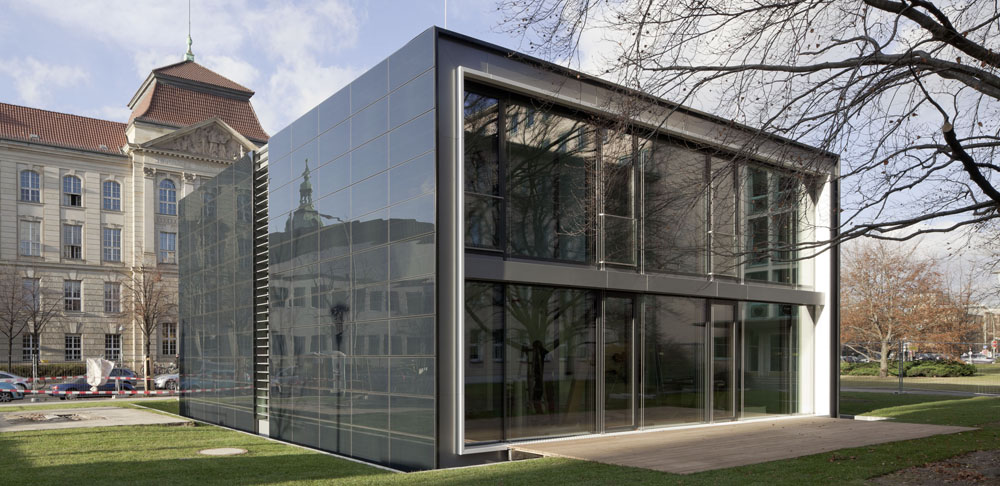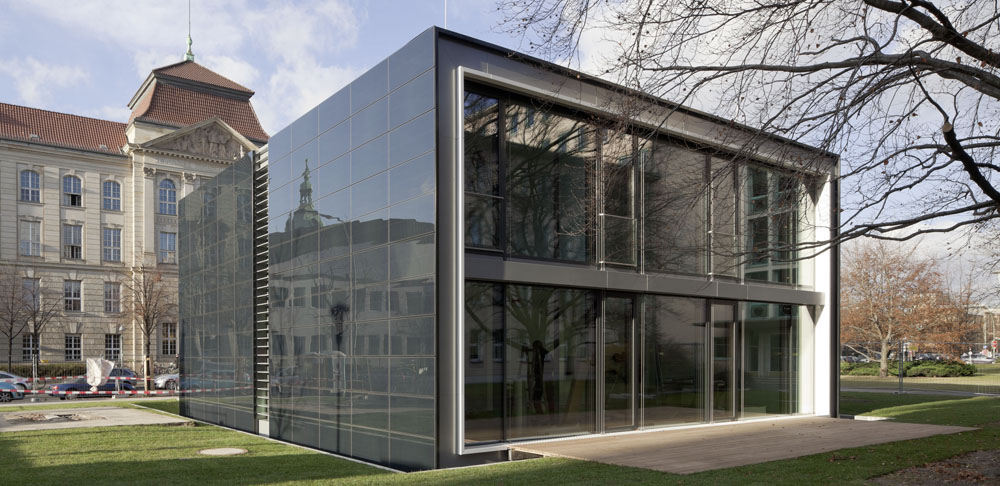Efficiency House Plus with Electric Mobility – Interim Report

Social scientific monitoring of the Efficiency House Plus with Electric Mobility in Berlin – Findings for building, living and mobility of the future: the development of highly efficient concepts for building and electric mobility has been initiated by the Federal Ministry of Transport, Building and Urban Development (BMVBS) as part of the Research Initiative 'Future Building'.
The Efficiency House Plus with Electric Mobility is an exemplary realisation of this approach by its combination of innovative developments in the areas of building and vehicle engineering. A family of four has been testing what it’s like to live in the model project since March 2012.
Considered over a period of one year, the house generates more energy than the family consumes for running the household and operating the building. This is facilitated by equipment using the latest photovoltaic and energy management technology, as well as information and communication technologies supporting intelligent and efficient utilisation of energy. The excess electricity produced can be used for electric mobility (cars, pedelecs). Electric cars are provided for this purpose by German automobile manufacturers for three-month periods. Another special feature is that the building can be disassembled into its individual components and recycled at the end of the project phase.
The two-storey single-family home is situated in a central location in the Charlottenburg district in West Berlin. It has a living space of 130 m² accommodating three bedrooms, two bathrooms, a utility room and a large living room with integrated kitchen. A covered parking and charging facility for the electric vehicles is located in front of the house.
A family of four was selected at the end of last year to start living in the house of the future in March 2012. Relevant information about living in an Efficiency House Plus will be gathered by means of a technical measurement monitoring and a social scientific monitoring conducted during this period of time. The project is the first real-life test of the efficient use of energy involving a combination of architecture and mobility conducted in Germany.
The two-storey single-family home is situated in a central location in the Charlottenburg district in West Berlin. It has a living space of 130 m² accommodating three bedrooms, two bathrooms, a utility room and a large living room with integrated kitchen. A covered parking and charging facility for the electric vehicles is located in front of the house.
A family of four was selected at the end of last year to start living in the house of the future in March 2012. Relevant information about living in an Efficiency House Plus will be gathered by means of a technical measurement monitoring and a social scientific monitoring conducted during this period of time. The project is the first real-life test of the efficient use of energy involving a combination of architecture and mobility conducted in Germany.
Selection of the family
A requirement profile for potential occupants was developed by the Berlin Institute for Social Research (BIS) in conjunction with the Federal Ministry of Transport, Building and Urban Development (BMVBS). A total of 132 families responded to the invitation for application that was placed in various publication media. A multi-step procedure based on various social scientific criteria and methods was used to select the future occupants of the Efficiency House. The application questionnaires and letters of motivation served to make a pre-selection of potential occupants. An important selection criterion included compliance with the requirement profile (e.g. number of family members, age of the children, professional activity of at least one parent). The next step involved assessment on the basis of further criteria (e.g. motivation to take part), resulting in a selection of ten potential families. After evaluation of all the data, a family was finally selected by Minister Peter Ramsauer in a public draw.
Aims of the social scientific monitoring
The objectives of the social scientific evaluation include obtaining information about the quality of living, mobility and energy efficiency, as well as about the suitability of the technologies used for everyday use and their influence on the well-being and daily life of the occupants. These findings can be used to develop standards for products and technologies that meet future demands on buildings and mobility and guarantee maximum user friendliness for the occupants. The degree of acceptance by the occupants can moreover be an important indicator for the chances of the Efficiency House Plus with Electric Mobility on the market.
Questions addressed
The qualitative social scientific monitoring aims to answer the following questions:
Methodical procedure
Important investigation instruments include:
First results
Evaluation of the interviews and logbooks to date has shown that the design, atmosphere and technical facilities in the house are received very positively by the occupants. The electric cars are also very popular. The occupants are keen on using the pedelecs as well as the two electric cars. Although the family did not have an own car before for environmental reasons, the cars are used frequently and with a clear conscience. Parts of the house automation and building equipment however still need some getting used to. These include ventilation sounds, sluggish response of the temperature regulation and hot water supply in some rooms, dry air, an undersized refrigerator and initial problems with some motion detectors. Outlook
The number of energy efficiency houses will increase in the future. This means that the development of measurement standards, both for technological and social scientific monitoring, is of particular importance in order to safeguard the comparability of projects. The provision of energy-efficient, intelligent housing and mobility combined with simultaneous evaluation of usage and acceptance, permits development of sustainable and scientifically based building and mobility concepts of the future. The current project makes an important contribution towards this.
A requirement profile for potential occupants was developed by the Berlin Institute for Social Research (BIS) in conjunction with the Federal Ministry of Transport, Building and Urban Development (BMVBS). A total of 132 families responded to the invitation for application that was placed in various publication media. A multi-step procedure based on various social scientific criteria and methods was used to select the future occupants of the Efficiency House. The application questionnaires and letters of motivation served to make a pre-selection of potential occupants. An important selection criterion included compliance with the requirement profile (e.g. number of family members, age of the children, professional activity of at least one parent). The next step involved assessment on the basis of further criteria (e.g. motivation to take part), resulting in a selection of ten potential families. After evaluation of all the data, a family was finally selected by Minister Peter Ramsauer in a public draw.
Aims of the social scientific monitoring
The objectives of the social scientific evaluation include obtaining information about the quality of living, mobility and energy efficiency, as well as about the suitability of the technologies used for everyday use and their influence on the well-being and daily life of the occupants. These findings can be used to develop standards for products and technologies that meet future demands on buildings and mobility and guarantee maximum user friendliness for the occupants. The degree of acceptance by the occupants can moreover be an important indicator for the chances of the Efficiency House Plus with Electric Mobility on the market.
Questions addressed
The qualitative social scientific monitoring aims to answer the following questions:
- Does the concept of the Efficiency House Plus with Electric Mobility correlate with user needs?
- Can user compatibility be increased by appropriate measures?
- Does living in an Efficiency House Plus give rise to an increase in sensitivity towards the environment and resources?
- Do changes in behaviour with regard to energy consumption occur?
- To what extent is this kind of living environment suitable for everyday life?
- Can the technology involved be used easily and intuitively?
- Are there any problems at the electromobility interface?
Methodical procedure
Important investigation instruments include:
- qualitative interviews just before moving in and after moving out, as well as at three-month intervals in between
- logbooks to be filled out every week; these contain questions about functions of the house, technical equipment, usage problems as well as a driver's logbook and charging logbook (for the electric cars and pedelecs)
- questionnaires to be filled out every three months; these are concerned with the behaviour, well-being, attitudes and satisfaction of the family
First results
Evaluation of the interviews and logbooks to date has shown that the design, atmosphere and technical facilities in the house are received very positively by the occupants. The electric cars are also very popular. The occupants are keen on using the pedelecs as well as the two electric cars. Although the family did not have an own car before for environmental reasons, the cars are used frequently and with a clear conscience. Parts of the house automation and building equipment however still need some getting used to. These include ventilation sounds, sluggish response of the temperature regulation and hot water supply in some rooms, dry air, an undersized refrigerator and initial problems with some motion detectors. Outlook
The number of energy efficiency houses will increase in the future. This means that the development of measurement standards, both for technological and social scientific monitoring, is of particular importance in order to safeguard the comparability of projects. The provision of energy-efficient, intelligent housing and mobility combined with simultaneous evaluation of usage and acceptance, permits development of sustainable and scientifically based building and mobility concepts of the future. The current project makes an important contribution towards this.
